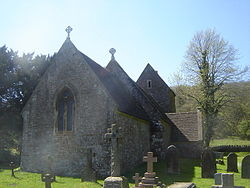St Brides Netherwent: Difference between revisions
Created page with "{{Infobox town |name=St. Brides Netherwent |county=Monmouthshire |picture=St. Brides Netherwent.jpg |picture caption=The church of St. Bridget |os grid ref=ST429895 |latitude=..." |
No edit summary |
||
| Line 20: | Line 20: | ||
The church of St. Bridget or Brigid is set in quiet countryside, adjoining the site of a deserted mediæval village.<ref>[http://www.geograph.org.uk/photo/409661 Geograph photo of deserted village]</ref> It was traditionally founded by Brochwael, the son of Meurig of [[Kingdom of Gwent|Gwent]], in the 10th century.<ref name=bradney>Joseph Bradney, ''A History of Monmouthshire: The Hundred of Caldicot'', 1933</ref> The church tower dates from the 13th or 14th century, but the body of the church was rebuilt in the 19th century after it became dilapidated.<ref name=Newman>John Newman, ''The Buildings of Wales: Gwent/Monmouthshire'', 2000, ISBN 0-14-071053-1</ref> | The church of St. Bridget or Brigid is set in quiet countryside, adjoining the site of a deserted mediæval village.<ref>[http://www.geograph.org.uk/photo/409661 Geograph photo of deserted village]</ref> It was traditionally founded by Brochwael, the son of Meurig of [[Kingdom of Gwent|Gwent]], in the 10th century.<ref name=bradney>Joseph Bradney, ''A History of Monmouthshire: The Hundred of Caldicot'', 1933</ref> The church tower dates from the 13th or 14th century, but the body of the church was rebuilt in the 19th century after it became dilapidated.<ref name=Newman>John Newman, ''The Buildings of Wales: Gwent/Monmouthshire'', 2000, ISBN 0-14-071053-1</ref> | ||
The parish was part of the mediæval lordship of Striguil. It is so named to distinguish it from the village of [[St Brides Wentloog]], in the west of the county. "Netherwent" is the name given from the Norman period onwards to the Welsh ''cantref'' of ''Gwent-is-coed'' (Gwent beneath the wood, i.e. Wentwood), with "-went" deriving from the Roman town of ''Venta'' which became Caerwent. | The parish was part of the mediæval lordship of Striguil. It is so named to distinguish it from the village of [[St Brides Wentloog]], in the west of the county. "Netherwent" is the name given from the Norman period onwards to the Welsh ''cantref'' of ''Gwent-is-coed'' (Gwent beneath the wood, i.e. [[Wentwood]]), with "-went" deriving from the Roman town of ''Venta'' which became Caerwent. | ||
The village was abandoned in the 18th century.<ref name=Newman/> | The village was abandoned in the 18th century.<ref name=Newman/> | ||
Revision as of 09:24, 15 August 2014
| St. Brides Netherwent | |
| Monmouthshire | |
|---|---|
 The church of St. Bridget | |
| Location | |
| Grid reference: | ST429895 |
| Location: | 51°36’5"N, 2°49’33"W |
| Data | |
| Post town: | Caldicot |
| Postcode: | NP26 |
| Dialling code: | 01291 |
| Local Government | |
| Council: | Monmouthshire |
| Parliamentary constituency: |
Newport East |
St. Brides Netherwent is a parish and largely deserted village in southeastern Monmouthshire. It is located two miles north of Magor, and three miles west of Caerwent. The A48 Newport to Chepstow road passes close by to the north.
History
The church of St. Bridget or Brigid is set in quiet countryside, adjoining the site of a deserted mediæval village.[1] It was traditionally founded by Brochwael, the son of Meurig of Gwent, in the 10th century.[2] The church tower dates from the 13th or 14th century, but the body of the church was rebuilt in the 19th century after it became dilapidated.[3]
The parish was part of the mediæval lordship of Striguil. It is so named to distinguish it from the village of St Brides Wentloog, in the west of the county. "Netherwent" is the name given from the Norman period onwards to the Welsh cantref of Gwent-is-coed (Gwent beneath the wood, i.e. Wentwood), with "-went" deriving from the Roman town of Venta which became Caerwent.
The village was abandoned in the 18th century.[3]
References
- ↑ Geograph photo of deserted village
- ↑ Joseph Bradney, A History of Monmouthshire: The Hundred of Caldicot, 1933
- ↑ 3.0 3.1 John Newman, The Buildings of Wales: Gwent/Monmouthshire, 2000, ISBN 0-14-071053-1